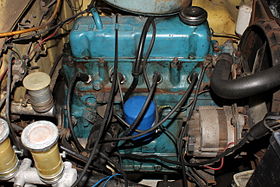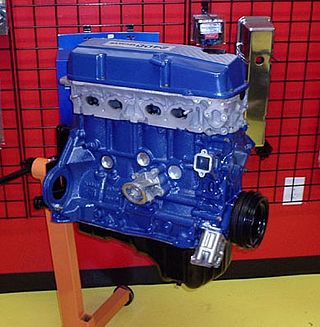
The KA engines were a series of four-stroke inline-four gasoline piston engines manufactured by Nissan, which were offered in 2.0 and 2.4 L. The engines blocks were made of cast-iron, while the cylinder heads were made of aluminum.

The CA engine is a series of 1.6 to 2.0 L Inline-4 piston engines from Nissan. It is designed for a wide variety of smaller Nissan vehicles to replace the Z engine and some smaller, four-cylinder L series engines. The "CA" stands for Clean Air, due to the installation of Nissan emission reducing technology, called NAPS-X.

The Nissan A series of internal combustion gasoline engines have been used in Datsun, Nissan and Premier brand vehicles. Displacements of this four-stroke engine family ranged from 1.0-liter to 1.5-liter and have been produced from 1967 till 2009. It is a small-displacement four-cylinder straight engine. It uses a lightweight cast iron block and an aluminum cylinder head, with overhead valves actuated by pushrods.
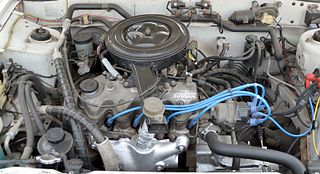
The Nissan E series name was used on two types of automobile engines. The first was an OHV line used in the late 1950s and throughout the 1960s. The second was an OHC version ranging from 1.0 to 1.6 litres and was produced from 1981 till 1988. It was replaced by the GA engine series.
The Nissan H series of automobile engines is an evolution of the Nissan "R" engine which was based on the 1.5-liter, three-main bearing "G" engine used in the 1960s. Both inline-four and inline-six versions were produced. It is a pushrod OHV design with iron block, early models with an iron head, later models with aluminum head. Versions of this motor have been used in many Nissan autos and forklifts, well into the eighties and a version called H20II was in production until 2003. The SD diesels are based on this series of motors

The Nissan L series of automobile engines was produced from 1966 through 1986 in both inline-four and inline-six configurations ranging from 1.3 L to 2.8 L. It is a two-valves per cylinder SOHC non-crossflow engine, with an iron block and an aluminium head. It was the engine of the Datsun 510, Datsun 240Z sports car, and the Nissan Maxima. These engines are known for their reliability, durability, and parts interchangeability.

The Nissan Z engine is a series of automobile and light truck four-cylinder engines that was engineered by Nissan Machinery, manufactured by the Nissan Motor Company from 1979 through August 1989. All Z engines had 4 cylinders, a total of 8 valves and a single overhead camshaft (SOHC). Displacements ranged from 1.6 L to 2.4 L.The Z series' engine blocks were nearly identical to those of the earlier L Series with the exception of the Z24. While the Z16 and Z18 engines had a deck height similar to the earlier L13/L14/L16/L18 variants, the Z24 had a taller deck height to accommodate a longer stroke. The most notable difference between the Z-series engine and its predecessor was the introduction of a new crossflow cylinder head which reduced emissions by moving the intake ports to the right side of the engine opposite the exhaust ports. This change allows the exhaust port velocity to more effectively scavenge the cylinder and reduce reversion pulses to enhance induction. This change also limits maximum valve lift/lobe lift profiles rendering the cylinder head and valve train configuration undesirable for high-performance uses. The Z series evolved into the NA and KA engines which, along with the smaller CA series, replaced the Z series.
The Nissan D-series is an overhead valve series of engines which first appeared in 1964, with the 1.05-liter D engine. Similar to a number of British and other Datsun engines, it may have been derived from an Ohta design which also found its way into some Kurogane vehicles - both of these companies were swallowed up by Nissan in the early 1960s.

The Prince G-series engine was the company's only straight-four and straight-six engines which began production in 1955. A number of variations were made, with both OHV and OHC heads. A diesel four-cylinder with 1.9 L (1,862 cc) was also built, called the D-6. The G series was used in the Skyline, the Laurel, and the Gloria from the 1950s to the early 1970s.

The Datsun Truck is a compact pickup truck made by Nissan in Japan from 1955 through 1997. It was originally sold under the Datsun brand, but this was switched to Nissan in 1983. It was replaced in 1997 by the Frontier and Navara. In Japan, it was sold only in Nissan Bluebird Store locations.

The HR is a family of straight-3 12-valve and straight-4 16-valve automobile engines with continuously variable valve timing, involving development by Nissan and/or Renault, and also Mercedes-Benz in the case of the H5Ht/M282. The designation of H engine is used by Renault, and M28x by Mercedes-Benz, to classify the family. There are three basic specifications of engine involving variations in engine architecture, or all-new architecture, with 72.2 mm (2.84 in), 75.5 mm (2.97 in) and 78 mm (3.07 in) bore diameter.
The SD engine was replaced by the Nissan TD engine. It was manufactured by Minsei Diesel Industries, Ltd., which was renamed Nissan Diesel Motor Co., Ltd in 1960.

The Nissan P engine is a large overhead valve, inline-six cylinder engine manufactured by Nissan Diesel Motor Co., Ltd. from 1959 to 2003 and used in light-duty trucks by Nissan, as well as in the Nissan Patrol. It replaced Nissan's older, sidevalve engines with which it shared its dimensions. This series of engines were based on the pre-war Type A engine, which was a license built Graham-Paige design.
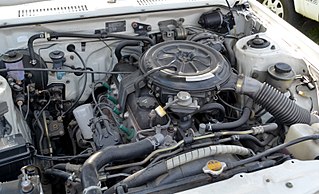
The Toyota Y engine is a series of overhead valve straight-four petrol engines manufactured by Toyota from 1982 through 1996. The Y engine has mostly been used in commercial and off-road vehicles.
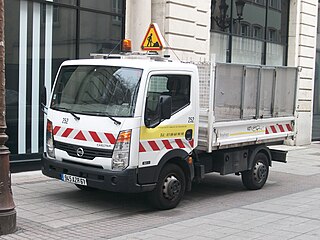
Nissan Cabstar is the name used in Japan for two lines of pickup trucks and light commercial vehicles sold by Nissan and built by UD Nissan Diesel, a Volvo AB company and by Renault-Nissan Alliance for the European market. The name originated with the 1968 Datsun Cabstar, but this was gradually changed over to "Nissan" badging in the early 1980s. The lighter range replaced the earlier Cabstar and Homer, while the heavier Caball and Clipper were replaced by the 2-4 ton range Atlas (kana:日産・アトラス). The nameplate was first introduced in December 1981.The Cabstar is known also as the Nissan Cabstar, Renault Maxity and Samsung SV110 depending on the location. The range has been sold around the world. It shares its platform with the Nissan Caravan. In spring 2014, Cabstar is now known as NT400.

The Prince Homer was a small commercial vehicle manufactured by the now integrated Prince Motor Company. It was available as a van, called the Homy, a double cab, or regular cab truck. The first model was known as the T64, and was sold as the Prince Homer or PMC T64. The T640 was introduced in 1966 and was sold as a Nissan due to Prince merging with Nissan. It was shared with the Nissan Cabstar which was sold at Nissan Bluebird Store Japanese dealerships. Production of the T640 ended in 1968. The Homer was exclusive to Japanese Nissan dealerships called Nissan Prince Store, when Prince was merged with Nissan in 1966. The Homer name was discontinued in 1982, while the Cabstar name remained when Nissan refocused Nissan Prince Store vehicles as private purchase products.

The Nissan NA family of straight-four engines is a series of engines manufactured by Nissan. It is the replacement of the Z series, on which its design is based, and is mostly used in commercial vehicles due to its use of Liquefied petroleum gas for fuel on engines with a "P" suffix code.
The Nissan TB straight-six petrol engine was released in 1987 as the TB42. Bore and stroke were 96 mm × 96 mm. Cubic capacity was 4,169 cc displacement). The engine was released with a two-barrel carburettor and a point type distributor. It was used in the Nissan Patrol Y60 and Y61 series.

The Nissan QD engine, successor to the Nissan TD engine, was an inline four-cylinder overhead valve diesel produced from the mid-1990s through 2000, with a turbocharger used on three variants, the QD32ETi(Elgrand and Terrano) QD32T and Qd32Ti(intercooled) in Chinese Markets. It was replaced by the Nissan ZD engine.

Nissan's sidevalve engines were based on the Austin 7 engine, with which they shared the 76 mm (2.99 in) stroke. The series began with a 495 cc iteration for the 1930 Datson Type 10 and ended with the 860 cc Type 10 engine which was built until 1964 for light commercial vehicles. Later versions were called the B-1, before being replaced in 1957 by the OHV Nissan C engine that was essentially a de-stroked version of another Austin design this time the BMC B-Series.
